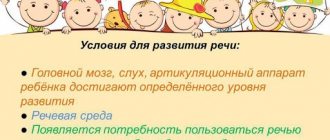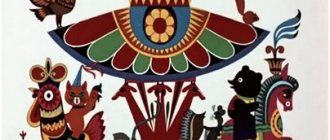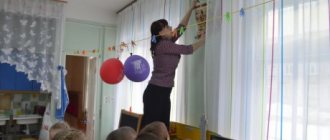MAGAZINE Preschooler.RF
Abstract of GCD on the topic “Cookware”Integration of educational areas: “Speech development” , “Cognitive development” , “Social and communicative development” , “Physical development” , “Artistic and aesthetic development”
Zodachi
- Expand children's understanding of the variety of dishes and their qualities; manufacturing materials. (Cognitive development).
- Continue to develop speech hearing; practice determining the position of sounds in a word; continue to learn how to make sentences with the conjunction a.
(Speech development).
3. Clarify and expand vocabulary on the topic “Tableware” : glass, porcelain, disposable, candy dish, bread box, cracker bowl, butter dish, milk jug, herring bowl. Introduce the formation of the compound word samovar. (Speech development)
4. To develop general and fine motor skills of pupils, the ability to combine movements with
speech. (Physical development).
5. Foster a caring attitude towards utensils (social and communicative development).
6. Continue to develop the ability to perform a game task in pairs, to coordinate your actions with the actions of your partner. (Social and communicative development).
7. Arouse an emotional mood from listening to a piece of music.
(Artistic and aesthetic development)
Materials and equipment: sets of dishes for different purposes from various materials: tea, coffee, dining, children's, plastic, porcelain, paper, metal, wood; rebus, markers; audio recording.
Preliminary work: reading a fairy tale by K.I. Chukovsky "Fedorino's grief"
GCD move
Organizational moment: Game “Give a smile to a friend”
Educator: guys, let's gather in a circle and pass on our smiles to each other. (a game)
Educator: I have a rebus for you - an encrypted word, if we guess it, we will find out what kind of object lies in our surprise chest.
dishes
In the first cell you need to write the letter that comes first in the surname of our boys Maxim Pilipenko and Maxim Pritvorov;
In the second cell - the letter that is the 4th in the name Veronica;
In the third - the fifth letter in the name Miroslav;
In the fourth - the third letter of Sofia Saulich's surname;
In the fifth - the third letter in the name Vadim;
The sixth is the last letter in the name Veronica.
(children guess)
Educator: Well done! Now let's see what's in our chest. That's right, these are dishes. Why do we need dishes? (to cook, eat, store food)
(There is a knock on the door. A dirty and disheveled Fedora comes in to the music. She cries)
Educator: guys, have you guessed who it is? That's right, this is Fedora from K. Chukovsky's fairy tale “Fedorino's grief” . Tell us Fedora, what are you upset about?
Fedora: Oh woe, woe is me, all the dishes left me.
Educator: Guys, do you know why Fedora left the dishes? Of course, dishes need to be kept clean and always put back in their place. Go, put yourself in order and the dishes will definitely come back to you.
(Fedora is still crying)
Fedora: I feel sorry for the dishes, they will break. Saucers, saucers, rush along the street. They bump into glasses... ding. And the glasses... ding - they break.
Educator: Guys, what kind of dishes can break? (made of glass, crystal, porcelain, clay). How should you handle it so that it doesn’t break? (carefully, carefully). What kind of dishes do not break (metal, wood, plastic, paper).
Fedora: ok guys, I’ll try to return the dishes.
Educator: Well, you and I are going to an exhibition of dishes.
(children look at dishes: tea, kitchen, children's, toys, made of various materials - wood, porcelain, glass, clay, plastic, metal.
A didactic game is being held : “What is which?”
Educator: Now we need to sort all the dishes. What do we call the teaware? coffee; for Game; for children; for cooking food?
(children name and lay out sets of dishes on napkins - tea set, coffee set; kitchen, children's, dining, disposable tableware)
Phys. minute: Let's play.
Here is a large glass teapot (puff up your tummy)
He is a very important boss (one hand on his belt, the other - to depict the spout of a teapot).
Here are the porcelain cups (sat down, hands on the belt).
Here are porcelain saucers (they are spinning, drawing a circle with their hands).
Just knock and they will break.
Here are the silver spoons (they stretched their hands up and closed them).
Here is a plastic tray, he brought us dishes.
Educator: Guys, take one piece of utensils that you liked the most and tell us about it.
(Children choose one piece of utensils and write a descriptive story.
Example: this is a teapot, it is made of metal, that means it is metal. It has a handle, a spout, a lid, a bottom, and walls. It boils water.)
The teacher draws attention to the large box.
Educator: here are utensils whose names contain food products. You must guess what these items are. We will put candy in a... candy bowl, butter in a... butter dish, bread in a bread box, herring in a... herring bowl, crackers in a rusk bowl, milk in a... milk jug, sugar in a sugar bowl.
(Children look at the dishes they guessed)
Educator: Please name the objects whose names contain the sound s and s.
How are these sounds similar and different?
(There is a knock on the door, a transformed Fedora comes in, holding a samovar.)
Fedora: Thank you guys, I did everything as you advised me: I washed myself, combed my hair and all the dishes came back to me. And for this I want to thank you. Look what I brought you! Do you know what this is? (samovar) And what two words are hidden in the word samovar? (he cooks it himself). It was called that because in ancient times they not only drank tea in a samovar, but also cooked soup and porridge. I also want to treat you to all sorts of sweets and give you delicious tea.
Educator: you are Fedorushka, sit down, relax, the guys will teach you how to make sentences with the conjunction a.
(Children are divided into pairs and choose sweets to taste; make sentences.
For example: I will drink tea with jam, and I will drink tea with sweets).
Fedora: you guys are great, you do it cleverly.
(Summarizing)
Educator: guys, tell Fedora what kind of dishes there are and what they are intended for (Holding a tea party)
| Next > |
Purpose of the lesson : to systematize ideas about food, utensils and the work of a cook.
Correctional educational tasks: To consolidate children's knowledge about food products, dishes obtained from these products, about the profession of a cook, and objects that make his work easier. Give an idea of the bunting bird. Continue to teach how to answer questions with complete and short answers. Consolidate, clarify and activate subject vocabulary, a dictionary of features on covered topics. Develop the grammatical structure of speech (form relative adjectives, form single-root and compound words). Continue to introduce the polysemy of words (oatmeal). Continue learning to guess word and silhouette riddles; introduce folk proverbs and sayings. Correctional and developmental tasks: Develop fine motor skills of the fingers; coordination of speech with movement; auditory and visual perception; memory, attention, logical thinking.
Educational objectives: To foster curiosity; independence, develop cooperation skills. Cultivate a respectful attitude towards the profession of a cook. Preliminary work: Examination of the painting “We Play Shop”, “Cooks”, excursion to the kitchen in kindergarten, arts and crafts classes (modeling, drawing, painting dishes), reading fiction: K.I. Chukovsky “Fedorino’s Mountain”, N .Nosov “Mishkina Porridge”, Brothers Grimm “A Pot of Porridge”, etc.; d/i “One-many”, “Say kindly”, “4 extra”, “What has changed?”, “Give me a word”, cut-out pictures, s/r game “Shop”, “Guests have come to us”. Individual work was carried out on memorizing poems about soups and healthy foods.
Equipment: Pots, pictures depicting food, posters depicting silhouettes of dishes, modules for houses, an audio recording with the voices of forest birds, a plastic basin with containers, objects depicting food, plates with pasted cereals, an illustration of a bird - oatmeal, disposable plates, condensed milk, fruits - grapes, orange, tangerine, raisins, suit for the cook, white caps for the cooks
Course of the lesson: Children sit in a semicircle. The teacher asks a riddle: - Tell me, who makes cabbage soup so deliciously, Smelly cutlets, Salads, vinaigrettes, All breakfasts, lunches? Who is this? (cook) - That's right, this is the cook. (There is a knock on the door. The cook appears. He greets the children.) Cook: Guys, find out what house I live in. My house is not low, but not high either, neither with a red nor a yellow roof. (5 different houses are built from modules - 1 high, 3 medium and 1 low, the colors of the houses and roofs are different). - That's right, I live in a yellow house with a blue roof. I have a lot of different dishes in my house, but I have my favorite one, which I use every day.
- From a hot well, water flows through the nose.
- Teapot girlfriend. Has two ears, cooks porridge and soup for Yulia. And her name is... (saucepan)
Cook: Kettle, saucepan - what can you call it in one word? What kind of tableware is it: tea, kitchen or dining? In my little house there are a lot of different utensils in the kitchen. And guess what! (The cook shows posters depicting silhouettes of dishes). I have a lot of different products in my kitchen. Food riddles:
- I don’t recommend confusing it with lubricant, when cars run better. And it comes in packs, as a viscous liquid, for animals and plants - for food. (oil)
- We all need white water. Make whatever you want from white water: Cream, yogurt, butter for our porridge, cottage cheese, pie. Eat, Vanyushka, my friend! (milk)
- I am a brother to cottage cheese, a matchmaker to sour cream, and a nephew to butter. And milk is my mother. (cheese)
- There are dairy products with pieces of fruit in them. Well, what kind of children can not like healthy...(yogurt) (we attach pictures to the board)
What products are these - meat, dairy or flour? In the kitchen I have many assistant appliances that help me prepare lunch tasty and quickly. Let's name them. Bread bakes - (Children: bread machine), bread cuts - (bread slicer), grinds coffee - (coffee grinder), brews coffee - (coffee maker), squeezes juice - (juicer), cuts vegetables - (vegetable slicer), and makes minced meat, or meat chops - (meat grinder). Well done! You named everything correctly. Educator: Now, let's relax and invite our friends to visit us. Physical education (song with movements is performed) 1. Guests have come to us, Dear ones have come. It was not in vain that we cooked jelly, baked pies 2. A pie with cabbage, and a pie with raspberries, and the one without filling is the most delicious pie. 3. Our kindergarten is famous for its Friendship. Come visit more often if you like. Cook: I have a lot of work to do in the kitchen. I need helpers. (Puts caps on the children.) - I am a cook, and you... (cooks, cook). What kind of chef's hat is it? (cook) Today we will prepare different soups for lunch. (On the table there are 4 pots, pictures depicting food products). - Artem, you will cook cabbage soup, Nina, you are Ukrainian borscht, Grisha is preparing pickle soup, and Maxim is preparing solyanka. There are products in front of you; you must select into the pans those products that you need to prepare the soup. (Children first select cards that show the desired products, then read poetry, showing the cards). Cabbage soup Pour hot cabbage soup for your family and friends. Boiled thickly: they contain carrots, cabbage, onions, potatoes, celery - slurp up the cabbage soup and don’t get sick. They are very good for the stomach and soul. Ukrainian borscht We love this fiery borscht even though our throats are covered in pepper and our lips are covered in butter. Beetroot, potatoes, carrots and cabbage and lard give us health - a little. We use a spoon passionately and with zeal, Borscht gives satiety and inspiration. Rassolnik Soak the pearl barley and boil it in broth. Without sparing your eyes and hands, chop the onions. After chopping carrots and potatoes, add them a little at a time. And pickled cucumber are the crowning glory of this dish. Add sour cream and dill to the steaming soup. And when you eat a portion, wipe your sweaty forehead. Solyanka This is a very hearty soup - a lot of meat and no grains. Remember, all types of meat work well here. Beef and tongue, sausage, frankfurters, bacon, ham and kidneys - all small pieces. Pickled cucumber will give a rich aroma. At the end, add olives, dill and parsley. When serving hodgepodge, don’t forget about sour cream. Cook: Thank you, cooks, you helped me a lot. Teacher: Guys, what other soups do you know? (children's answers). Russians' favorite food is cabbage soup and porridge. Therefore, it is not without reason that people say: “Soup soup and porridge are our food.” I'll check now, do you know porridge? (Shows plates with cereals pasted on them. Children look at and name the porridge.) This porridge is oatmeal. In England this porridge is called oatmeal. And there is a bird called a bunting. Imagine that we are in a clearing in the forest, where you can hear birds singing. Now I will tell you about a bird - oatmeal. (Accompanied by an audio recording of the voices of birds in the forest, the teacher talks about the bird). Cook: While the guests are getting ready, let's set the table: lay out a tablecloth, put out cups and saucers. Each thing has its place: we will put butter (where?) - (Children: in a butter dish), we will pour sugar (where?) - in a sugar bowl, we will pour milk (where?) - in a milk jug, we will put crackers (where?) - in a cracker bowl, put candy (where?) - in a candy bowl, put lemon (where?) - in a lemon bowl, and put napkins (where?) - in a napkin holder. Well done! Everything was named correctly. Look how beautifully our table is set. Teacher: In hospitable Russia it has always been believed: “The hut is not red in its corners, but red in its pies.” Tell me why Russia is hospitable? (Guests were greeted with bread and salt). Let us knead the dough and bake pies. Come to me. (The game “Dry Pool” is played. Among the containers there are small items: apple, carrot, fish, mushroom, pear, cabbage, chicken) - Knead, knead the dough, There is room in the oven. There will be pies and rolls coming out of the oven. (Children imitate kneading). — Pies come with different fillings. What kind of pie do you have? (Fish - fish, etc.) They say about a good cook: “A good cook is worth a doctor.” (Explain: our health depends on the quality of the dishes prepared by the cook, that’s why people say so) Come to this table, look, plates have been prepared for each of you. What's in them? (condensed milk). Right. And on these plates there are fruits. What fruits did you recognize? (grapes, kiwi, tangerine slices, raisins) Raisins are dried grapes. Let's use fruits and berries to create a portrait of a good chef. You will place the fruits on plates with condensed milk not with your hands, but with toothpicks. Place a piece of fruit on one toothpick and help place it on a plate with the other. (Children sit at the tables and complete the task) Teacher: Well done! What beautiful portraits you have created, and they are all different, interesting, and not alike. Cook: I also really liked the portraits, you made a real dessert. Well, I have to go, I still have a lot of work to do. Goodbye! Teacher: Guys, did you like the lesson? What did you like most about the lesson? (children's answers). The cook and I also really liked you, you know and can do a lot. Well done! After class, you will wash your hands and eat your dessert portraits. Now let’s treat our guests to fruits (pieces of the same fruits are stabbed on skewers). Children: To grow, you need food: Fruits, vegetables, water, Porridge, milk and bread, Soup with cutlet for lunch. And less often - chocolate, cake and lemonade with gas. Then you will be healthy without drugs and doctors. (treat guests)



